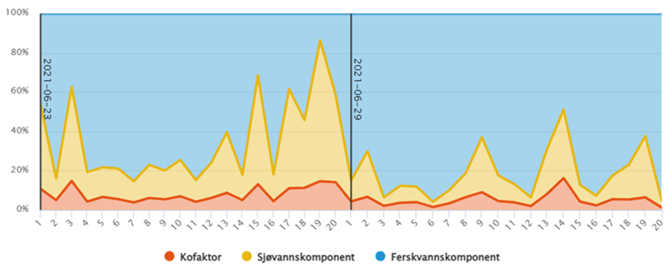The autumn marine transfer of smolt is well underway. Here’s a concise look at smolt production and the role our smoltification tool, Smoltvision, can play in supporting optimal transfers of populations
Production of Autumn Smolt – From Tradition to Modern Technology
Traditionally, autumn smolt production has been a "zero-year" process, meaning a more intensive production cycle with a shorter time for the fish in the facility and smaller margins to ensure proper smoltification. In today’s smolt production, which oftenrelies on recirculating aquaculture systems (RAS), the distinctions between production seasons have become less pronounced, making the differences between zero-year and one-year production much smaller.
Differences Between Autumn and Spring Smolt in Various Facility Types
In flow-through facilities, autumn fish have often been considered easier to smoltify than spring fish. This is because autumn fish are typically smaller, making them easier to manage with light, temperature, and salinity. Additionally, there are fewer problems with hemorrhagic smolt syndrome (HSS) due to the shorter production period—a known factor that can affect smoltification.
SmoltVision – A Precise Tool for Smolt Status
Many factors can affect the smoltification process, so it’s important to use good tools that provide precise answers about the smolt status of the fish. SmoltVision analyzes both freshwater ATPase and seawater ATPase, giving a thorough picture of how the smoltification process is progressing, both at the individual and group level. In addition, cofactors can provide extra information about underlying factors that might irritate or negatively affect the gills, such as gill-related agents or water quality.
Example 1: Smoltification in RAS Facilities

Figure 1: The graph shows the percentage distribution of freshwater ATPase (blue), seawater ATPase (yellow), and cofactor (red) for each individual in the sample. The results show that the group as a whole has a high level of seawater ATPase at the start of the sample series, and that it consolidates at a consistently high expression of seawater ATPase at the last sampling.
This example in Figure 1 shows a typical smoltification process for autumn fish in RAS facilities. The fish group has an average weight of 200 g at release. The fish have been exposed to continuous 24:0 light at 12.5°C, with a steady salinity of 3 ppt. The fish have also received smoltification feed during the last month before release. SmoltVision results show that the group is already well underway with smoltification at the first sampling, with several individuals seawater-ready, though with some variation in the group. The second sample was taken when smoltification feed was introduced, and the amount of seawater ATPase increased steadily in the group, with reduced variation in seawater tolerance. The last sample shows consistently high seawater ATPase expression in all individuals, indicating the group is now seawater-ready and prepared for release.
Challenges with Autumn Smolt in Flow-Through Facilities
Autumn smolt can be challenging for flow-through facilities, especially during periods of drought and warm weather, which reduce water availability. This can lead to high water temperatures, which in turn affect the fish’s appetite and the smoltification process. Combined with high biomass, there is also a risk of elevated CO₂ levels in the tanks, which can inhibit the expression of seawater ATPase and thus affect smoltification.
Example 2: Temperature Stress in Western Norway Facilities

Figure 2: The graph shows a clearly dominant expression of freshwater (blue) ATPase at the first sampling, which increases further at the second sampling. This is the opposite of what one expects when the fish have started smoltification, but can occur when the process is disturbed, e.g., by high temperature, high CO₂, or disease.
In the example from Figure 2, we see a flow-through facility in Western Norway struggling with high temperatures up to 18°C towards the end of the smoltification period, leading to a challenging smoltification process. The facility has outdoor tanks and uses natural light. During the sampling period, temperatures ranged from 15.7°C to 17.5°C. The fish received salt feed to synchronize and group them in the smolt window, but the high temperature caused their appetite to drop, so the salt stimulus from the feed was not utilized. The fish had a smolt index of 4.0 and appeared morphologically ready for sea release. There was a clearly dominant expression of freshwater ATPase at the first sampling, which increased further as temperatures rose towards the last sampling.
SmoltVision as a Decision-Making Tool
Today, SmoltVision is used both to document the smolt status of fish before release—so buyers or recipients can be confident the fish are seawater-ready and prepared for life at sea—and as a tool to improve and optimize the smoltification process in more challenging production scenarios, such as when introducing new technology or equipment. Small changes in production can affect the smoltification process, so it’s important to have thorough analyses, which, together with information about fish behavior, morphology, and other parameters, form a solid basis for deciding the best possible time for release into the sea.
PHARMAQ is the global leader in vaccines and innovation for aquaculture and part of Zoetis, the world leader in animal health. The company provides environmentally sound, safe and efficacious health products to the global aquaculture industry through targeted research and the commitment of dedicated people. Production facilities, administration and research and development activities are based in Norway with subsidiaries in Chile, United Kingdom, Vietnam, Turkey, Spain, Panama and Hong Kong. PHARMAQ has approximately 300 employees. The company's products are marketed in Europe, North and South America, and Asia. For further information, visit the company's website at www.pharmaq.com. Privacy Policy. Cookie Policy. Terms of Use.
Copyright © 2020 Zoetis LLC. All rights reserved.